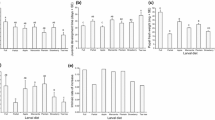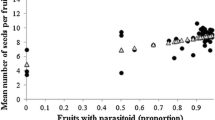Abstract
Herbivore fitness can be altered by a combination of interacting organisms, such as its food plant, conspecifics, and predators/parasitoids. Here, we tested relative effects of plant species, herbivore intraspecific competition type, and spatial distribution of the herbivore among plant units on herbivore survival and whether parasitoids modified these effects. We used an endophagous bruchine seed predator Callosobruchus maculatus for the herbivore, and a braconid wasp Heterospilus prosopidis for the parasitoid. The survival rate of C. maculatus was measured for each of 16 combinations of two plants (bean species, Vigna unguiculata and V. radiata), two competition types of C. maculatus larvae (contest and scramble), two spatial distributions of hosts [sparse (1 C. maculatus larva per seed over 20 seeds) and dense (2 C. maculatus larvae per seed over ten seeds)], and with/without a parasitoid pair. In the absence of the parasitoid, C. maculatus survival rate was lower with V. radiata and in the contest type. With the parasitoid, the proportion parasitized hosts was independent of total host density. Neither the proportion of parasitized hosts nor host survival rate was affected by plant species or host strain, but they were affected by host spatial distribution. When host distribution was dense, a higher proportion of hosts were parasitized, and C. maculatus survival rate was lower. Here we discuss parasitoid potential as a selective agent for the sparse within-pod distribution of its hosts in the field.



Similar content being viewed by others
References
Agnew P, Hide M, Sidobre C, Michalakis Y (2002) A minimalist approach to the effects of density-dependent competition on insect life-history traits. Ecol Entomol 27:396–402
Ayabe Y, Tuda M, Mochizuki A (2008) Benefits of repeated mine trackings by a parasitoid when the host leafminer has a tortuous feeding pattern. Anim Behav 76:1795–1803
Beardsley JW (1961) A review of the Hawaiian Braconidae (Hymenoptera). Proc Hawaii Entomol Soc 17:333–366
Biere A, Elzinga JA, Honders SC, Harvey JA (2002) A plant pathogen reduces the enemy-free space of an insect herbivore on a shared host plant. Proc R Soc B 269:2197–2204
Cameron TC, Wearing HJ, Rohani P, Sait SM (2005) A koinobiont parasitoid mediates competition and generates additive mortality in healthy host populations. Oikos 110:620–628
Carton Y, Sokolowski MB (1992) Interactions between searching strategies of Drosophila parasitoids and the polymorphic behavior of their hosts. J Insect Behav 5:161–175
Cattell MV, Stiling P (2004) Tritrophic interactions and trade-offs in herbivore fecundity on hybridising host plants. Ecol Entomol 29:255–263
Clausen CP (1978) Introduced parasites and predators of arthropod pests and weeds: a world review. Agricultural Handbook No. 480. USDA Agriculture Research Service, Washington DC
Colegrave N (1997) Can a patchy population structure affect the evolution of competition strategies? Evolution 51:483–492
Credland PF, Dick KM, Wright AW (1986) Relationships between larval density, adult size and egg production in cowpea seed beetle, Callosobruchus maculatus. Ecol Entomol 11:41–50
Cronin JT (2009) Habitat edges, within-patch dispersion of hosts, and parasitoid oviposition behaviour. Ecology 90:96–207
Eklöv P, Svanbäck R (2006) Predation risk influences adaptive morphological variation in fish populations. Am Nat 167:440–452
Fox CW, Savalli UM (1998) Inheritance of environmental variation in body size: superparasitism of seeds affects grand-progeny body size via a non-genetic maternal effect. Evolution 52:172–182
Fujii K (1983) Resource dependent stability in an experimental laboratory resource-herbivore-carnivore system. Res Popul Ecol Suppl 3:15–26
Godfray HCJ (1994) Parasitoids: behavioral and evolutionary ecology. Princeton University Press, Princeton
Guedes RNC, Smith RH, Guedes NMP (2003) Host suitability, respiration rate and the outcome of larval competition in strains of the cowpea weevil, Callosobruchus maculatus. Physiol Entomol 28:298–305
Hatcher MJ, Dick JTA, Dunn AM (2006) How parasites affect interactions between competitors and predators. Ecol Lett 9:1253–1271
Hemerik L, Yano E (2010) A simulation model for the functional response of Orius sauteri on eggplant leaves with Thrips palmi: implications for biological control. Proc Neth Entomol Soc Meet 21:61–74
Hoffmann JH, Impson FAC, Moran VC (1993) Competitive interactions between two bruchid species (Algarobius spp.) introduced into South Africa for biological control of mesquite weeds (Prosopis spp.). Biol Control 3:215–220
Horng S-B (1997) Larval competition and egg-laying decisions by the bean weevil, Callosobruchus maculatus. Anim Behav 53:1–12
Ito M, Hijii N (2002) Factors affecting refuge from parasitoid attack in a cynipid wasp, Aphelonyx glanduliferae. Popul Ecol 44:23–32
Jones TH, Turner BD (1987) The effect of host spatial distribution on patterns of parasitism by Nasonia vitripennis. Entomol Exp Appl 44:169–175
Jones BC, Vamosi SM (2010) Limited evidence for size-based discrimination of oviposition sites in Callosobruchus maculatus (Coleoptera: Bruchinae). eJ Biol Sci 2:31–39
Kobayashi A, Shimada M (2000) Field sex ratio of a braconid parasitoid wasp, Heterospilus prosopidis (Hymenoptera: Braconidae), in the southwestern United States: concordance with host-quality model. Ann Entomol Soc Am 93:819–824
Lane SD, Mills NJ (2003) Intraspecific competition and density dependence in an Ephestia kuehniella–Venturia canescens laboratory system. Oikos 101:578–590
Lawrence PO (1981) Host vibration—a cue to host location by the parasite, Biosteres longicaudatus. Oecologia 48:249–251
Lill JT (1998) Density dependent parasitism of the hackberry nipplegall maker (Homoptera: Psyllidae): a multi-scale analysis. Environ Entomol 27:657–661
Messina FJ (2004) Predictable modification of body size and competitive ability following a host shift by a seed beetle. Evolution 58:2788–2797
Messina FJ, Karren ME (2003) Adaptation to a novel host modifies host discrimination by the seed beetle Callosobruchus maculatus. Anim Behav 65:501–507
Messina FJ, Mitchell R (1989) Intraspecific variation in the egg-spacing behavior of the seed beetle Callosobruchus maculatus. J Insect Behav 2:727–742
Mikolajewski DJ, Johansson F, Wohlfahrt B, Stoks R (2006) Invertebrate predation selects for the loss of a morphological antipredator trait. Evolution 60:1306–1310
Nachman G (2006) A functional response model of a predator population foraging in a patchy habitat. J Anim Ecol 75:948–958
Pexton JJ, Mayhew PJ (2002) Siblicide and life-history evolution in parasitoids. Behav Ecol 13:690–695
Pitt WC, Ritchie ME (2002) Influence of prey distribution on the functional response of lizards. Oikos 96:157–163
Reeve JD, Rhodes DJ, Turchin P (1998) Scramble competition in the southern pine beetle, Dendroctonus frontalis. Ecol Entomol 23:433–443
Rundle HD, Vamosi SM, Schluter D (2003) Experimental test of predation’s effect on divergent selection during character displacement in sticklebacks. Proc Natl Acad Sci USA 100:14943–14948
Schmale I, Wäckers FL, Cardona C, Dorn S (2001) Control potential of three hymenopteran parasitoid species against the bean weevil in stored beans: the effect of adult parasitoid nutrition on longevity and progeny production. Biol Control 21:134–139
Shimada M (1999) Population fluctuation and persistence of one-host-two-parasitoid systems depending on resource distribution: from parasitizing behaviour to population dynamics. Res Popul Ecol 41:69–79
Shimada M, Fujii K (1985) Niche modification and stability of competitive systems. I. Niche modification process. Res Popul Ecol 27:185–201
Smith RH (1990) Adaptations of Callosobruchus species to competition. In: Fujii K, Gatehouse AMR, Johnson CD, Mitchell R, Yoshida T (eds) Bruchids and legumes: economics, ecology and coevolution. Kluwer, Netherlands, pp 351–360
Smith RH, Lessells CM (1985) Oviposition, ovicide and larval competition in granivorous insects. In: Sibly RM, Smith RH (eds) Behavioural ecology: ecological consequences of adaptive behaviour. Blackwell, Oxford, pp 423–448
Spitzen J, van Huis A (2005) Effect of host quality of Callosobruchus maculatus (Coleoptera: Bruchidae) on performance of the egg parasitoid Uscana lariophaga (Hymenoptera: Trichogrammatidae). Bull Entomol Res 95:341–347
Sugimoto T, Shimono Y, Hata Y, Nakai Y, Yahara M (1988) Foraging for patchily-distributed leaf-miners by the parasitoid, Dapsilarthra rufiventris (Hymenoptera, Braconidae) III. Visual and acoustic cues to a close range patch-location. Appl Entomol Zool 23:113–121
Takano M, Toquenaga Y, Fujii K (2001) Polymorphism of competition type and its genetics in Callosobruchus maculatus (Coleoptera: Bruchidae). Popul Ecol 43:265–273
Taper ML (1990) Experimental character displacement in the adzuki bean weevil, Callosobruchus chinensis. In: Fujii K, Gatehouse AMR, Johnson CD, Mitchell R, Yoshida T (eds) Bruchids and legumes: economics, ecology and coevolution. Kluwer, Netherlands, pp 289–301
Thanthianga C, Mitchell R (1987) Vibrations mediate prudent resource exploitation by competing larvae of the bruchid bean weevil Callosobruchus maculatus. Entomol Exp Appl 44:15–22
Toquenaga Y, Fujii K (1991) Contest and scramble competitions in Callosobruchus maculatus (Coleoptera: Bruchidae). I. Larval competition curves and resource sharing patterns. Res Popul Ecol 33:199–211
Toquenaga Y, Ichinose M, Hoshino T, Fujii K (1994) Contest and scramble competitions in an artificial world: genetic analyses with genetic algorithms. In: Langton CC (ed) Artificial life III. Addison-Wesley, Boston, pp 177–199
Tuda M (1995) Spatio-temporal population structures and host-parasitoid system dynamics. Doctoral dissertation, University of Tokyo, Tokyo
Tuda M (1996) Temporal/spatial structure and the dynamical property of laboratory host-parasitoid systems. Res Popul Ecol 38:133–140
Tuda M (1998) Evolutionary character changes and population responses in an insect host-parasitoid experimental system. Res Popul Ecol 40:293–299
Tuda M, Iwasa Y (1998) Evolution of contest competition and its effect on host-parasitoid dynamics. Evol Ecol 12:855–870
Tuda M, Shima K (2002) Relative importance of weather and density dependence on the dispersal and on-plant activity of the predator Orius minutus. Popul Ecol 44:251–257
Tuda M, Shimada M (1995) Developmental schedules and persistence of experimental host-parasitoid systems at two different temperatures. Oecologia 103:283–291
Tuda M, Shimada M (2005) Complexity, evolution, and persistence in host-parasitoid experimental systems with Callosobruchus beetles as the host. Adv Ecol Res 37:37–75
Utida S (1944) Host-parasite interaction in the experimental population of the azuki bean weevil, Callosobruchus chinensis (L.) II. The effect of density of parasite population on the growth of the host population and also of the parasite population II. Oyo-Dobutsu 15:2–18 (in Japanese with an English summary)
Vamosi SM (2005a) Interactive effects of larval host and competition on adult fitness: an experimental test with seed beetles (Coleoptera: Bruchidae). Funct Ecol 19:859–864
Vamosi SM (2005b) On the role of enemies in divergence and diversification of prey: a review and synthesis. Can J Zool 83:894–910
Vamosi SM, Lesack TL (2007) Direct effects of larval competition on development time and fecundity in seed beetles. Evol Ecol Res 9:1131–1143
van Alebeek FAN, Bezemer TM, van Huis A, van Lenteren JC (1996) The functional response of Uscana lariophaga under different egg distributions of its host Callosobruchus maculatus. Entomol Exp Appl 81:227–233
Van Buskirk J, Yurewicz KL (1998) Effects of predators on prey growth rate: relative contributions of thinning and reduced activity. Oikos 82:20–28
van Huis A, Schütte C, Sagnia S (1998) The impact of the egg parasitoid Uscana lariophaga on Callosobruchus maculatus populations and the damage to cowpea in a traditional storage system. Entomol Exp Appl 89:289–295
Vet LEM (2001) Parasitoid searching efficiency links behaviour to population processes. Appl Entomol Zool 36:399–408
Wang XG, Johnson MW, Daane KM, Yokoyama VY (2009) Larger olive fruit size reduces the efficiency of Psyttalia concolor, as a parasitoid of the olive fruit fly. Biol Control 49:45–51
Weis E, Abrahamson WG, McCrea KD (1985) Host gall size and oviposition success by the parasitoid Eurytoma gigantea. Ecol Entomol 10:341–348
Yanagi S, Tuda M (2010) Interaction effect among maternal environment, maternal investment and progeny genotype on life history traits in Callosobruchus chinensis. Funct Ecol 24:383–391
Yasuda H, Ishikawa H (1999) Effects of prey density and spatial distribution on prey consumption of the adult predatory ladybird beetle. J Appl Entomol 123:585–589
Zaviezo T, Mills N (2000) Factors influencing the evolution of clutch size in a gregarious insect parasitoid. J Anim Ecol 69:1047–1057
Acknowledgments
We thank P. Abrams and L. Rowe for logistic support, D. Punzalan for advice about insect husbandry, M. Couray, D. Punzalan, and J. Wheeler for stoically engaging in scraping countless eggs off seeds for the main experiment, and K. Kagoshima for measurement of parasitoid size. T. Cameron, D. Gwynne, K. Judge, and P. Molloy provided insightful feedback on earlier versions of the manuscript. This study was supported by NSERC through a Postdoctoral Fellowship to SMV and Discovery Grants to P. Abrams, L. Rowe and SMV, and by MEXT and JSPS through Grants in Aid for Young Scientists (15770011) and for Scientific Research (19510237) to MT.
Author information
Authors and Affiliations
Corresponding author
Rights and permissions
About this article
Cite this article
Vamosi, S.M., den Hollander, M.D. & Tuda, M. Egg dispersion is more important than competition type for herbivores attacked by a parasitoid. Popul Ecol 53, 319–326 (2011). https://doi.org/10.1007/s10144-010-0248-z
Received:
Accepted:
Published:
Issue Date:
DOI: https://doi.org/10.1007/s10144-010-0248-z




